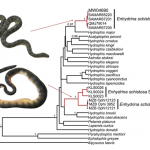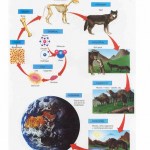evolution
Ken Ham is preaching about what science is again. He's accusing the secular activist Zack Kopplin of being "brainwashed" by evolutionist propaganda, and to support this claim, he once again drags out the tired proposition that there are two kinds of science, historical and observational, and that only the observational kind is valid; well, unless the historical version is based on the Bible, which in his dogma is an unassailable compendium of absolutely true facts about the past.
What’s more, Kopplin—like almost all evolutionists—confuses historical science with operational (observational)…
Eugene McCarthy, the author of that crackpot stabilization theory, has discovered my review and is now making a noise on twitter. He's gone from thanking me profusely for mentioning him, to whining that I stole his figures, to complaining that I don't understand his theory at all, all in the last 24 hours.
But here's the fun part. Recall that one of his bizarre claims is that whales did not evolve from terrestrial artiodactyls, but from mosasaurs, mesozoic marine reptiles, instead. But the anatomy shows that mosasaurs are derived squamates, reptiles, with a completely different skeletal…
“Aristotle taught that stars are made of a different matter than the four earthly elements— a quintessence— that also happens to be what the human psyche is made of. Which is why man’s spirit corresponds to the stars. Perhaps that’s not a very scientific view, but I do like the idea that there’s a little starlight in each of us.” -Lisa Kleypas
Ah, but what if you did want the scientific view of starlight? After all, it's through the very stars themselves that we've unveiled some of the greatest secrets of the Universe.
Image (mosaic) credit: Nick Risinger.
But while the stars of the…
[This past fall, I taught a course at Emerson College called "Plagues and Pandemics." I'll be periodically posting the contents of my lectures and my experiences as a first time college instructor]
Most of this post was written back in September, when it still seemed possible that I would be able to teach the class, write the blog and do science. Please forgive any anachronisms that I failed to purge.
Last time, I talked about what science is and why it's awesome. This is the first half of lecture 2, which was originally given on 11 September, 2012.
Lecture 2a (reading: Zimmer - The…
This is another addition to my αEP series about evolutionary psychology. Here's the first, and unfortunately there are several more to come.
By the way, people are wondering about the α in the title. Don't you people do any immunology? α is standard shorthand for "anti".
I mentioned in the last one this annoying tendency of too many pro-evolution people to cite "complexity" as a factor that supports the assertion of selection for a trait. Strangely, the intelligent design creationists also yell "Complexity!" at the drop of a hat, only it's to prove that evolution can't work.
They're both…
This is another addition to my αEP series about evolutionary psychology. Here's the first, and unfortunately there are several more to come.
I have a real problem with evolutionary psychology, and it goes right to the root of the discipline: it's built on a flawed foundation. It relies on a naïve and simplistic understanding of how evolution works (a basic misconception that reminds me of another now-dead discipline, which I'll write about later) — it appeals to many people, though, because that misconception aligns nicely with the cartoon version of evolution in most people's heads, and it…
Back in February, paleontologist Robert Asher wrote this essay for HuffPo. The essay was called, “Why I am an Accommodationist,” and it defended the compatibility of science and religion. As regular readers of this blog are aware, I don't much care for that view. So I wrote this reply. After a long break, Asher has now replied to my reply, over at The Panda's Thumb. I thank him for taking the time to have to done so. However, I am not moved by his remarks to revise anything I said in my original post. So let's go one more round, and have a look at what he has to say.
After a brief…
The current issue of e-Skeptic features three book reviews I recently wrote, discussing books related to the evolution of evolution. The three books were Darwin's Ghosts: The Secret History of Evolution, by Rebecca Stott; Darwin the Writer, by George Levine; and American Genesis: The Evolution Controversies from Scopes to Creation Science, by Jeffrey Moran. I liked all three! Properly juxtaposed, they tell a complete story, from the early history of evolutionary thought, often carried out in secret for fear of retaliation from religious authorities, as documented by Stott's book, through…
I find the following bit of video to be very interesting. The letter itself, which they read at the beginning, is instructive of why many people are creationists or otherwise anti-science. They are afraid to go to hell. The idea that a person will go to hell for believing in science is something you have to be taught. The people who teach this should ... well, they can go to hell, as far as I'm concerned.
Then, of course, the answer to the letter is amazing. It is a revolution in thinking. Please keep in mind that the person making the statements you are about to witness is the…
As organisms spread into new habitats, they diverge and differentiate to best adapt to their surroundings. But when separated species exploit similar niches, their body plans begin to converge, and they end up looking a lot like each other. Such is the case with Beaked Sea Snakes, uber-venomous consumers of spiny catfish and blowfish, long thought to be a single species but now shown by genetic analysis to be two. Meanwhile, PZ Myers considers the Creationist discipline of baraminology, which self-consciously strives to minimize the number of animals Noah needed to fit on his ark. Dr. Jean K…
“We live in an atmosphere of shame. We are ashamed of everything that is real about us; ashamed of ourselves, of our relatives, of our incomes, of our accents, of our opinions, of our experience, just as we are ashamed of our naked skins.” -George Bernard Shaw
All that is real about ourselves is nothing to be ashamed about; quite to the contrary, it's something to be eminently thankful for. This very existence is all we have, and while it's minuscule compared to the entire Universe, it required the entire Universe to bring us to the point where it's possible for us to exist.
What do…
Sea snakes are true snakes that look a little like eels because of their horizontally flattened rudder-like tails, and they spend a lot of time...for most species, their entire lives...in the ocean. Only one species seems to be able to move on land at all. They seem to all be venomous, some extremely so. They are all tropical or near-tropical, and there are numerous species distributed among about 15 genera.
One species is Enhyrina schistosa, known as the Beaked Sea Snake, or the Hook-Nosed Sea Snake. It lives in the waters near Indonesia and Australia. This is known to be the most…
The Reports of the National Center for Science Education has just posted a new review of my book Among the Creationists. The reviewer is Taner Edis, professor of physics at Truman State University in Kirksville, Missouri. Since Edis's own books on science and religion, The Ghost in the Machine and Science and Nonbelief are among my favorites on this subject, his opinion means a lot to me. So, did he like the book?
Jason Rosenhouse, who teaches mathematics at James Madison University, might at first
seem an unlikely person to be interested in the creationism/evolution wars. Creationism isa…
Our rebuttal to claims about the adaptive significance of the female orgasm has been published, as Zietsch & Santtila's study is not evidence against the by-product theory of female orgasm. I blogged about this a while back, and also dealt with some counter-arguments, and Elisabeth Lloyd thought my arguments were strong enough to be incorporated into a letter, so there you go…now I just need a badge or a t-shirt with a proclamation about my expertise on it.
Wallen K, Myers PZ, Lloyd EA (2012) Zietsch & Santtila’s study is not evidence against the by-product theory of female orgasm.…
"I am always ready to learn, although I do not always like to be taught." -Winston Churchill
My very first time leading a classroom -- on my own -- was back in June of 2000. I was 21 years old, fresh out of college, and was teaching science in a middle school classroom. And I asked what I thought was an innocuous question, designed to pique their curiosity. I asked the class, "What are we -- you, me, and all human beings -- made of?"
I was expecting many possible answers common to all living things, ranging from "blood and guts" to cells, molecules, or atoms. From a scientific…
The story of 'How we know where HIV-1 came from' is really cool-- A group of researchers went into the jungles of Africa, collected lots of monkey poop, and figured out pretty much the exact colony of chimpanzees that transmitted their SIV into humans, which lead to the HIV epidemic we know today.
Those researchers have struck brown gold again!
Eastern Chimpanzees, but not Bonobos, Represent a Simian Immunodeficiency Virus Reservoir
There are lots of different kinds of 'HIV'. Apparently, all of the HIV-1 (Group M is causing the HIV epidemic in humans, and then Group N and O) we…
Over at Uncommon Descent, there's a bit of a kerfuffle going on about the second law of thermodynamics. Salvador Cordova got the ball rolling back in July with this barn-burner of a post excoriating his fellow ID proponent Granville Sewell for making bad thermodynamical arguments:
ID proponents and creationists should not use the 2nd Law of Thermodynamics to support ID. Appropriate for Independence Day in the USA is my declaration of independence and disavowal of 2nd Law arguments in support of ID and creation theory. Any student of statistical mechanics and thermodynamics will likely find…
I just watched this neat presentation given a few years back by Dr. Robert Sapolsky from Stanford University on the differences and similarities between humans and animals:
On Pharyngula, PZ Myers considers a computer model which posits that bones are simply exoskeletons turned inside-out. Myers writes “We know from the homology of the patterning molecules involved that vertebrates and invertebrates are upside-down relative to each other, so at some point an ancestor flipped.” Such major differences in body plan arise during embryonic development, driven by highly evolved genetic instruction. But the growth of internal and external skeletons depends on distinct biological mechanisms, leading PZ to call the dataless computer model “abiological and ahistorical…
In my post bashing that silly article claiming to have figured out how endoskeletons evolved from exoskeletons, there was a good question buried in the comments, and I thought I'd answer it.
Are there any models pulled out of arses which explain the turtle's unique skeleton?
Yes! I mean, no, not pulled out of arses, but there is a lot of really good and persuasive research that uses evidence to show how the turtle skeleton evolved.
First, I can see how this question popped up in a discussion of the evolution of endo/exoskeletons: the turtle shell is an excellent example of an exoskeleton…




